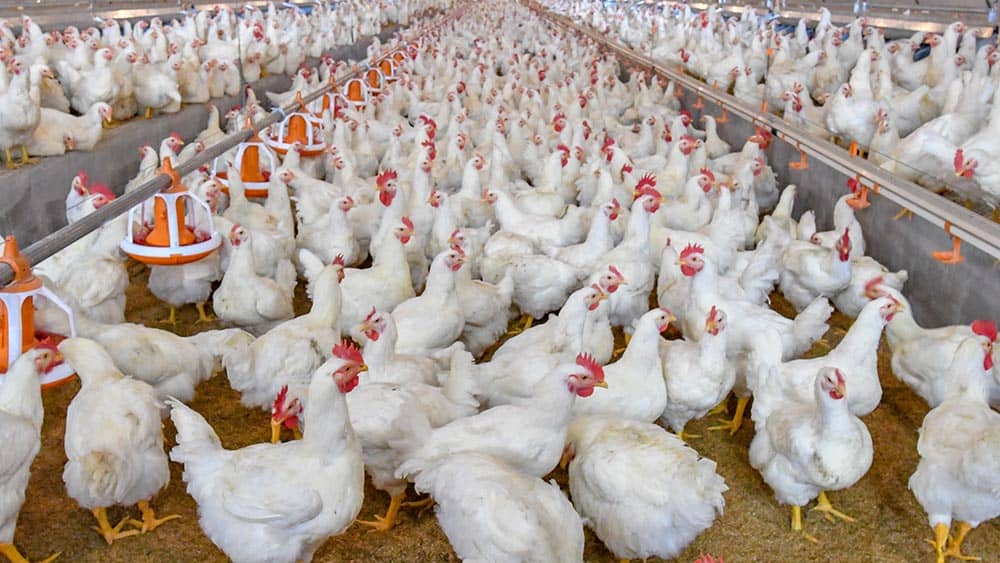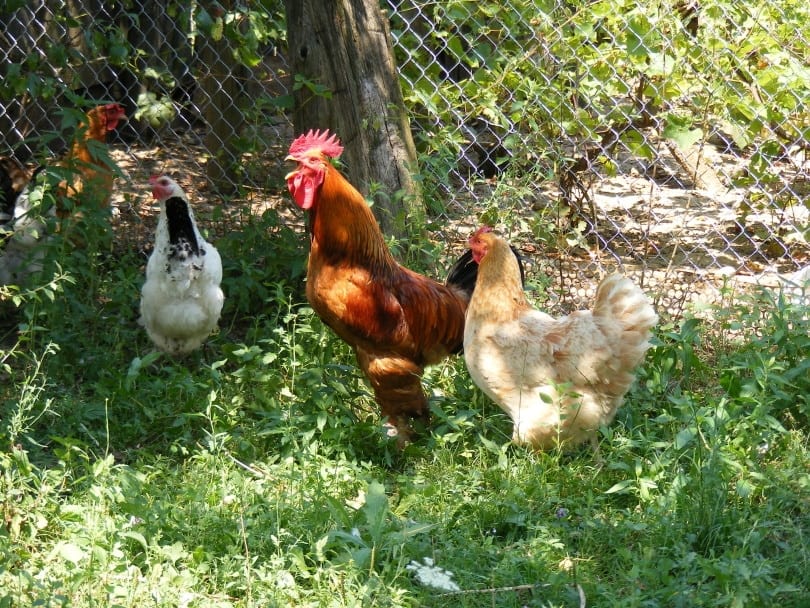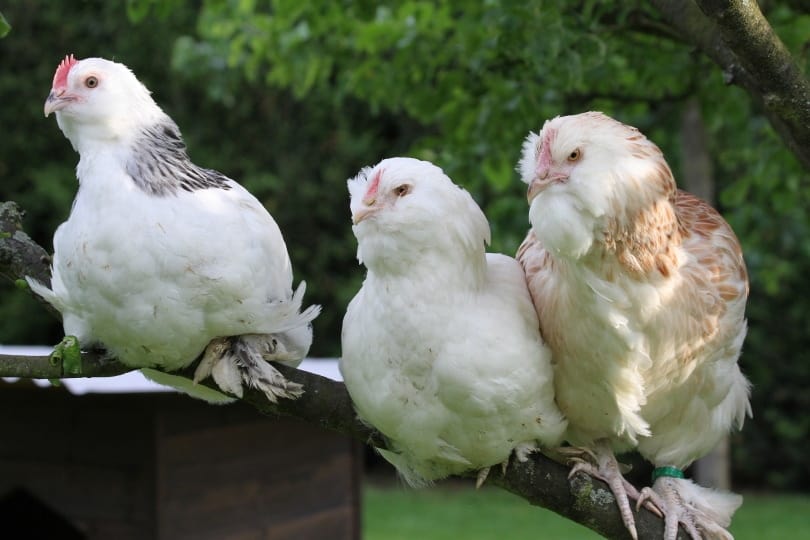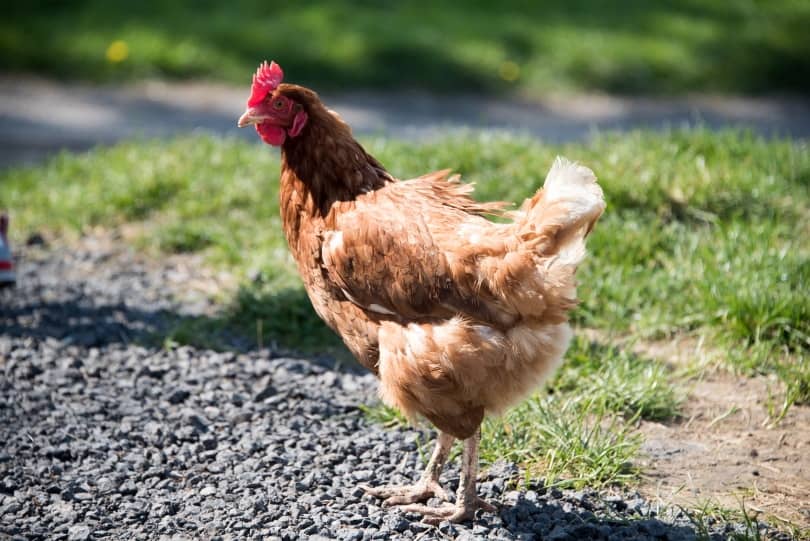Chickens can indeed be cannibals. However, they usually don’t intend to be. Besides hunger, there can be something else driving the behavior. Most birds aren’t trying to simply eat another bird. Instead, it is a byproduct of a different behavior.
For instance, chickens and most other poultry species establish dominance within groups. In some cases, this attempt at dominance can escalate into violence and eventually cannibalism. If a bird attacks and kills another bird, it will often continue to attack them, which can appear to be cannibalism.
Feather pecking can also lead to cannibalism. Once the bird has plucked all the feathers away in an area, they may begin to pluck the skin instead. Therefore, this can cause the bird to eat the skin of another, though that isn’t the main point of their behavior.
Stress can also lead to cannibalism. When a bird is stressed, it will often try to take it out on another bird, typically one lower in the pecking order.
This underlying stress can be caused by a large variety of things. For instance, overheating, nutritional deficiencies, genetics, and overcrowding can all contribute to cannibalism.
Cannibalism can cause significant amounts of mortality and stress, which then leads to more cannibalism. For this reason, it is essential to keep it to a minimum if you’re looking to maintain a healthy flock.

The 4 Causes of Cannibalism in Chickens
Chickens are omnivores, when means that they can eat both plants and meat — including the meat of other chickens.
However, chickens are mainly herbivores in adulthood. Most of their diet is grains.
Many cases of cannibalism are attached to feather pecking. Therefore, the chicken isn’t necessarily trying to eat the other one — it is trying to pluck its feathers. However, once enough feathers have been plucked, they can begin to tear away at the skin instead.
Sadly, this behavior is usually done in groups. Therefore, the targeted bird has little chance to escape.
That said, there are plenty of other causes too.

1. Light Intensity
Intense light can cause cannibalism. While the reason isn’t completely understood, it is thought to be linked with stress. Plus, higher light levels often cause overheating, which can also lead to stress and discomfort.
2. Nutritional Issues
While cannibalization usually isn’t linked to nutrition, there are some cases where malnutrition can cause increased aggression and raise cannibalization rates. For instance, a lack of methionine can cause increased aggressive behaviors. This amino acid is found in feathers, which may explain some of the feather-pecking behaviors associated with cannibalism.
In some cases, chickens can accidentally peck other birds when attempting to eat. Therefore, it is essential that they are spread out to mimic natural feeding behaviors. Otherwise, cannibalism can occur accidentally.
3. Overcrowding
Overcrowding can make birds stand too close together. During feeding time, this may cause accidental pecks, which can eventually lead to cannibalism.
Furthermore, birds tend to fight more when they are packed together. The less-dominant birds don’t have a chance to get away from the dominant birds, which leads to everyone fighting more often.
On top of this, in groups larger than 30, the social hierarchy may break down. Often, groups of this size may not recognize a dominant bird, which will lead to more fighting. The social order will continuously try to correct itself, though that isn’t always possible in such a big group. Therefore, the birds may fight constantly.

4. Injury
It is quite common for chickens to cannibalize injured birds. Chickens are attracted to the color red. Therefore, if another bird is bleeding, it may poke at the blood.
Furthermore, one chicken eliminating another may increase their rank in the social order, which can encourage more pecking.
The 6 Ways to Prevent Cannibalism in Chickens

There are several ways to reduce cannibalism in chickens.
1. Size Control
You should keep groups of chickens relatively small. The more chickens that you have in a group, the higher the chance for cannibalism.
2. Light Control
You should keep lighting to a minimum. In some cases, lights are used to scare off predators or encourage hens to use nesting boxes. However, intense lights can also stress hens out and cause cannibalism.
3. Selective Breeding
Certain family lines of chickens are simply more likely to cannibalize others. Therefore, selectively breeding chickens without these problems may reduce them.
4. Beak-trimming
If you’re looking to severely reduce the risk of cannibalism, one of the most proven methods is beak-trimming. Since this method is quite effective, it is also popular. Studies have found that this method reduces deaths from cannibalism by about half.
That said, beak trimming can cause both acute and chronic pain in the chicken. Therefore, it is seen as cruel and inhumane by many people. Furthermore, beak trimming can affect a bird’s ability to forage and experience its world.
5. Perches
Studies have found that providing a hen with perches by the time that it is 4 weeks old reduces cannibalistic behaviors throughout its life.

6. Eyewear
A new method of reducing cannibalism is through the use of eyewear. The hens are outfitted with a specific type of eyewear, though the exact type can vary. Rose-tinted glasses are commonly used, as are blinders. It is thought that rose-tinted glasses prevent the bird from recognizing the color red, which prevents cannibalistic behaviors.
Conclusion
All birds have the potential to be cannibalistic. Usually, this behavior is caused by stress of some sort. Keeping your chickens as stress-free as possible can prevent cannibalistic behaviors.
There are several other ways that you can prevent cannibalism. For instance, you can use specially made glasses or reduce the number of chickens in one coop.
- You may also want to know: Can Cats Get Concussions? What You Need To Know!
Featured Image Credit: Carl Jones Photography, Shutterstock
